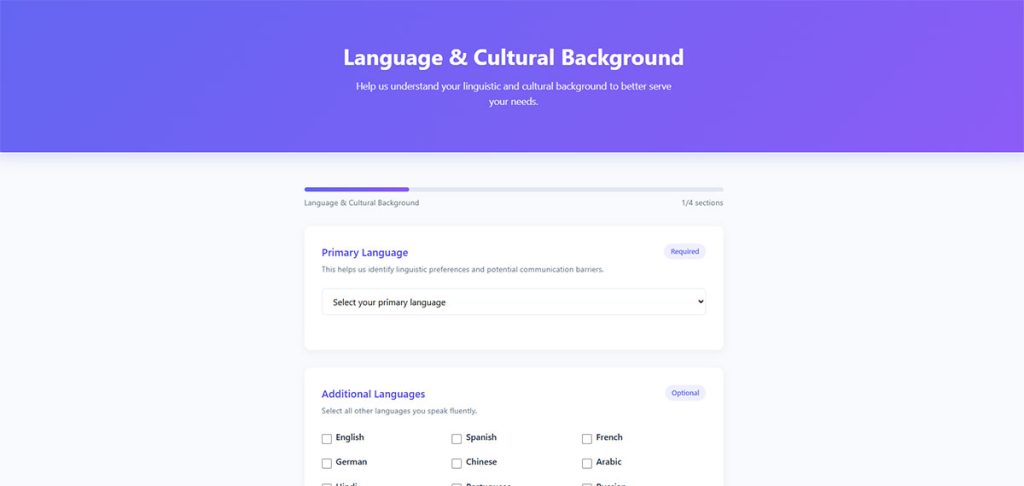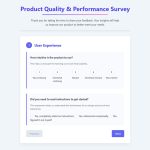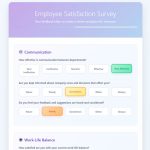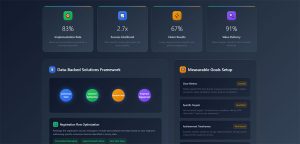You send a survey. Half your audience ignores it. The other half quits halfway through. Sound familiar? Survey fatigue is killing your response rates and destroying data quality. When participants…
Table of Contents
Knowing your audience isn’t just helpful. It’s essential.
Demographic survey questions unlock powerful insights about age demographics, educational background, income levels, and household characteristics. When you understand your market segmentation, you make smarter business decisions.
Every successful organization relies on demographic data to shape strategies. From market research firms to product developers, understanding your target demographics drives real results. The right questions reveal consumer profiling insights that transform raw data into actionable intelligence.
This article shows you how to craft demographic survey questions that get responses. You’ll learn:
- Key demographic categories to explore
- How to structure questions for maximum response rates
- Best practices for sensitive topics
- Ways to ensure data privacy and compliance
- Templates you can adapt for your research
Whether you’re designing a survey form or conducting audience analysis, you’ll find practical examples and proven techniques to gather meaningful demographic research efficiently.
Demographic Survey Questions
Basic Demographics
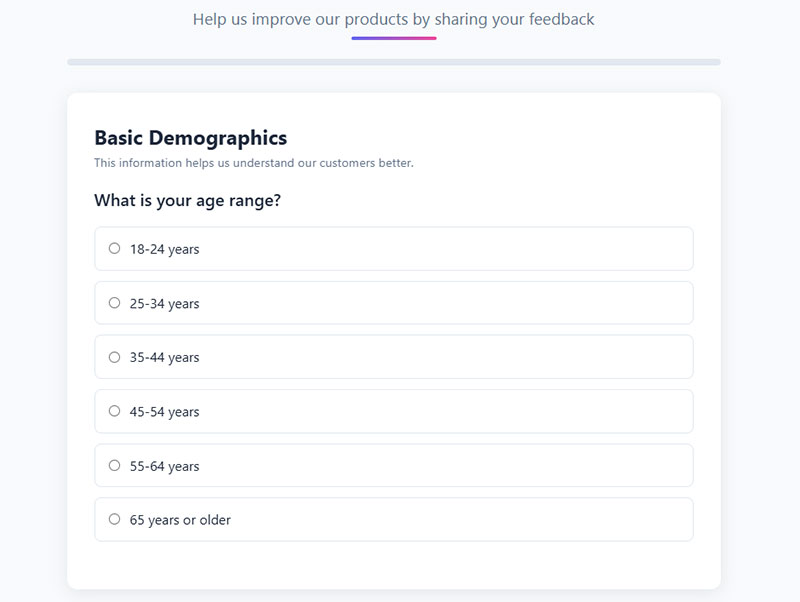
Age Range
Question: What is your age range?
Type: Multiple Choice (predefined ranges, e.g., “18-24,” “25-34,” “35-44,” etc.)
Purpose: Helps segment responses by generation and life stage, providing insights into age-related patterns and preferences.
When to Ask: Standard inclusion in most demographic surveys; position early in the survey as it’s non-threatening.
Gender Identity
Question: What is your gender?
Type: Multiple Choice with write-in option (e.g., “Male,” “Female,” “Non-binary,” “Prefer to self-describe: ____,” “Prefer not to say”)
Purpose: Enables analysis of gender-based differences in responses and ensures representation across gender identities.
When to Ask: Include in standard demographic sections; consider placing after less sensitive questions.
Race/Ethnicity
Question: What is your race/ethnicity?
Type: Multiple Choice with multi-select option and write-in (following census categories with additions as needed)
Purpose: Helps ensure diverse representation in research and allows for analysis of cultural differences in responses.
When to Ask: Place in the demographic section; consider wording that acknowledges the complexity of racial/ethnic identity.
Education Level
Question: What is your highest level of education completed?
Type: Single-select Multiple Choice (e.g., “Less than high school,” “High school graduate,” “Some college,” “Bachelor’s degree,” etc.)
Purpose: Indicates educational background which may influence preferences, comprehension levels, and socioeconomic factors.
When to Ask: Standard demographic question that can be placed anywhere in the demographic section.
Employment Status
Question: What is your current employment status?
Type: Single-select Multiple Choice (e.g., “Employed full-time,” “Employed part-time,” “Self-employed,” “Unemployed,” etc.)
Purpose: Provides context on professional life, time availability, and economic circumstances that may affect behaviors and preferences.
When to Ask: Include in standard demographic sections; useful for most market and social research.
Household Income
Question: What is your annual household income range?
Type: Single-select Multiple Choice with ranges (e.g., “Under $25,000,” “$25,000-$49,999,” etc.)
Purpose: Indicates purchasing power and economic circumstances that may influence decision-making and preferences.
When to Ask: Place toward the end of the demographic section as it’s considered sensitive; always make optional.
Marital Status
Question: What is your marital status?
Type: Single-select Multiple Choice (e.g., “Single,” “Married,” “Domestic partnership,” “Divorced,” etc.)
Purpose: Provides insight into household structure and potential decision-making influences.
When to Ask: Standard demographic question that can be included in most surveys.
Location Information
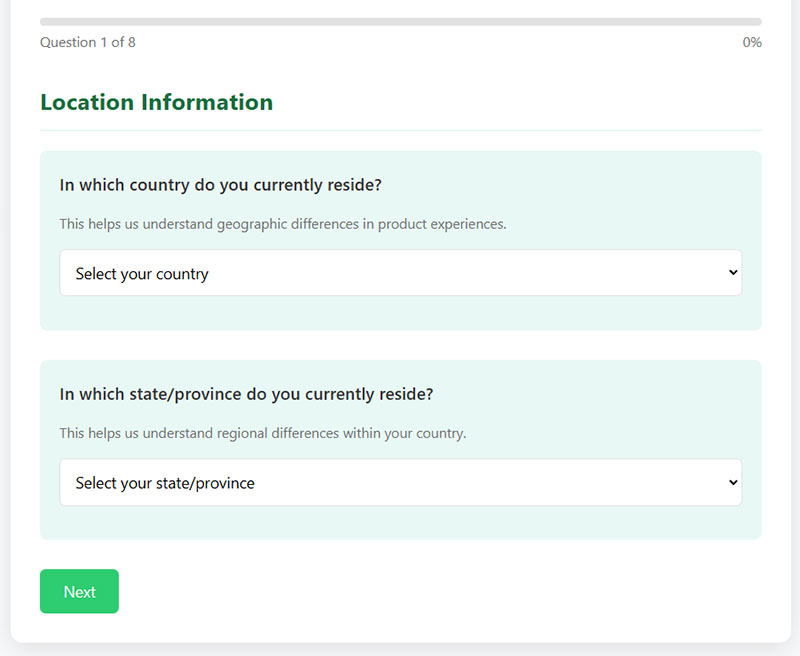
Country of Residence
Question: In which country do you currently reside?
Type: Dropdown or autocomplete text field
Purpose: Enables geographic segmentation and accounts for cultural, economic, and regulatory differences between countries.
When to Ask: Typically near the beginning of the demographic section; can be used as a screening question if targeting specific regions.
State/Province of Residence
Question: In which state/province do you currently reside?
Type: Dropdown or autocomplete text field (conditional on country selection)
Purpose: Allows for regional analysis within countries and accounts for local differences in regulations, culture, and economy.
When to Ask: Immediately following the country question; sometimes used as a screening question for regionally targeted research.
Residential Setting
Question: Do you live in an urban, suburban, or rural area?
Type: Single-select Multiple Choice (e.g., “Urban (city),” “Suburban,” “Rural,” “Don’t know”)
Purpose: Captures differences in lifestyle, access to services, and environmental contexts that may influence responses.
When to Ask: Include in the location section of demographic questions when geographic lifestyle factors are relevant.
Residential Tenure
Question: How long have you lived at your current address?
Type: Single-select Multiple Choice (e.g., “Less than 1 year,” “1-3 years,” “4-10 years,” “More than 10 years”)
Purpose: Indicates residential stability and potential community integration which may affect local knowledge and behaviors.
When to Ask: Include when community engagement or local services are relevant to the research focus.
Household Composition
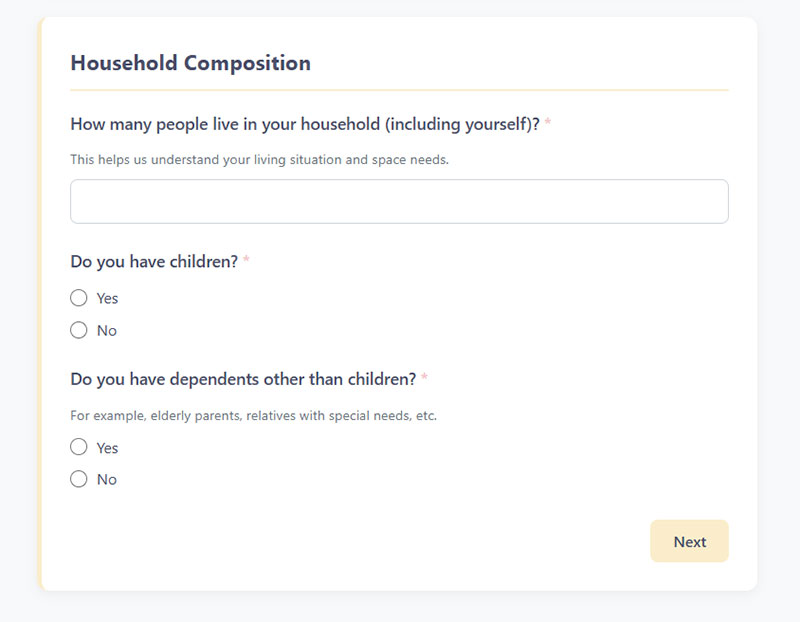
Household Size
Question: How many people live in your household (including yourself)?
Type: Numeric input or single-select Multiple Choice
Purpose: Provides context about living situation that may influence space needs, purchasing decisions, and lifestyle considerations.
When to Ask: Include when household dynamics or shared resources are relevant to the research focus.
Children in Household
Question: Do you have children? If yes, how many and what are their ages?
Type: Conditional question – Yes/No with follow-up numeric fields and age ranges
Purpose: Identifies parental status and life stage, which significantly influence priorities, purchasing decisions, and time constraints.
When to Ask: Include when family dynamics or products/services for children or parents are relevant.
Other Dependents
Question: Do you have dependents other than children? If yes, please specify.
Type: Yes/No with conditional open text field
Purpose: Identifies caregiver responsibilities beyond traditional parenting that may affect priorities, time allocation, and financial decisions.
When to Ask: Include when caregiving responsibilities could be relevant to the research focus.
Language & Cultural Background

Primary Language
Question: What is your primary language?
Type: Dropdown or autocomplete text field
Purpose: Identifies linguistic preferences and potential communication barriers; helps ensure appropriate translation needs.
When to Ask: Early in surveys where language preferences might affect comprehension or when language services are relevant.
Additional Languages
Question: What other languages do you speak fluently?
Type: Multiple-select checkboxes or multi-select dropdown
Purpose: Identifies multilingual capabilities which may indicate cultural exposure and communication preferences.
When to Ask: Include when cultural fluency or language skills are relevant to the research objectives.
Country of Birth
Question: What is your country of birth?
Type: Dropdown or autocomplete text field
Purpose: Provides insight into cultural background and potential immigrant experiences that may influence perspectives and preferences.
When to Ask: Include when cultural origins are relevant to the research focus; be mindful of sensitivity.
Time in Current Country
Question: If not born in your current country of residence, how long have you lived there?
Type: Conditional single-select Multiple Choice (e.g., “Less than 1 year,” “1-5 years,” “6-10 years,” “More than 10 years”)
Purpose: Indicates level of acculturation and familiarity with local systems for immigrant respondents.
When to Ask: Include as a follow-up to country of birth when migration experience is relevant to the research.
Employment & Financial
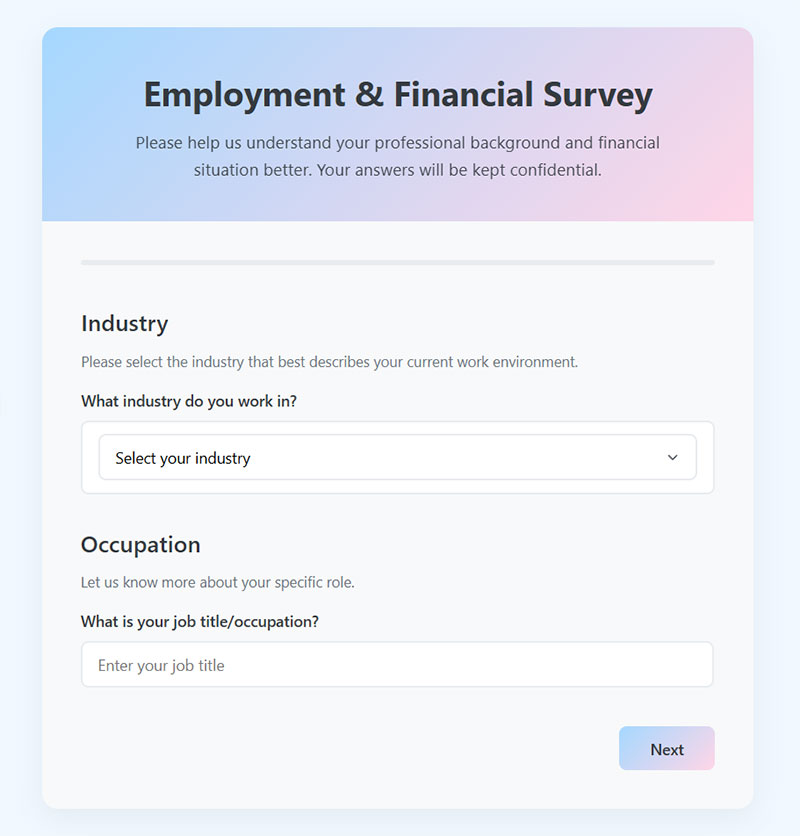
Industry
Question: What industry do you work in?
Type: Dropdown or autocomplete text field with standard industry classifications
Purpose: Provides professional context that may influence expertise, interests, and exposure to certain products or services.
When to Ask: Include when professional background is relevant to the research topic.
Occupation
Question: What is your job title/occupation?
Type: Open text field or autocomplete with common titles
Purpose: Offers more specific insight into professional role, responsibilities, and potential skill sets.
When to Ask: Include when specific professional roles or expertise are relevant to the research.
Working Hours
Question: How many hours per week do you typically work?
Type: Single-select Multiple Choice (e.g., “Less than 20 hours,” “20-39 hours,” “40 hours,” “More than 40 hours”)
Purpose: Indicates time constraints and work-life balance issues that may affect availability, stress levels, and consumption patterns.
When to Ask: Include when work-life balance or time constraints are relevant to the research focus.
Housing Status
Question: Do you own or rent your home?
Type: Single-select Multiple Choice (e.g., “Own,” “Rent,” “Live with family/friends without paying rent,” “Other”)
Purpose: Provides insight into housing stability, financial commitment, and ability to make property modifications.
When to Ask: Include when housing circumstances or home-related decisions are relevant to the research.
Primary Earner Status
Question: Are you the primary earner in your household?
Type: Single-select Multiple Choice (e.g., “Yes,” “No,” “Equal contribution with partner/spouse,” “Prefer not to say”)
Purpose: Indicates financial decision-making role within the household that may affect purchasing authority and priorities.
When to Ask: Include when household financial dynamics are relevant to purchasing decisions being studied.
Additional Contextual Information

Disability Status
Question: Do you have any disabilities? If comfortable sharing, please specify.
Type: Yes/No with optional open text field or multiple-select checkboxes for common disabilities
Purpose: Ensures inclusion of diverse accessibility needs and experiences; helps identify potential barriers to product/service use.
When to Ask: Include when accessibility or diverse physical/cognitive experiences are relevant; always make optional.
Religious Affiliation
Question: What is your religious affiliation, if any?
Type: Single-select Multiple Choice with “Other” write-in and “Prefer not to say” options
Purpose: Provides insight into potential value systems, cultural practices, and community affiliations that may influence perspectives.
When to Ask: Include only when religious background is truly relevant to the research; always make optional.
Political Affiliation
Question: What is your political affiliation, if any?
Type: Single-select Multiple Choice with “Other” write-in and “Prefer not to say” options
Purpose: Indicates ideological tendencies that may influence opinions on certain topics, particularly those with political dimensions.
When to Ask: Include only when political perspective is clearly relevant to the research topic; always make optional.
Primary Digital Device
Question: What type of device do you primarily use to access the internet?
Type: Single-select Multiple Choice (e.g., “Smartphone,” “Laptop/desktop computer,” “Tablet,” “Smart TV,” etc.)
Purpose: Identifies technological context for digital experiences and potential device-specific constraints or preferences.
When to Ask: Include when digital experiences or device-specific behaviors are being studied.
Technology Proficiency
Question: How would you rate your technological proficiency?
Type: Scale (e.g., 1-5 from “Not at all proficient” to “Extremely proficient”)
Purpose: Self-assessed measure of comfort with technology that may influence adoption of digital solutions and features.
When to Ask: Include when digital literacy or technology adoption is relevant to the research focus.
FAQ on Demographic Survey Questions
What are demographic survey questions?
Demographics questions collect data about population characteristics like age groups, gender distribution, education levels, and household income. Market research firms use these to understand respondent profiles and segment audiences. They form the foundation of consumer demographics analysis.
Why are demographic questions important?
They enable precise market segmentation and target audience identification. Businesses use demographic data to tailor products, services, and marketing strategies. Research companies rely on this information for statistical analysis and population sampling. Demographics drive data-driven decision making.
What are the most common demographic categories?
Key categories include:
- Age demographics and generation categories
- Gender options
- Income brackets and socioeconomic status
- Educational background
- Geographic location
- Employment status
- Marital status and family composition
These form standard demographic profiling elements.
How do I ask about sensitive demographic information?
Use optional response fields. Provide inclusive answer choices. Explain why you need the data. Ensure data privacy compliance. Some organizations use ranges instead of exact figures for income levels or age groups to increase comfort.
Should demographic questions come first or last in a survey?
Place them at the end. Starting with demographic data can feel intrusive. Build trust with topic-related questions first. Survey methodology experts recommend closing with demographics unless they’re essential for screening survey respondents early.
How many demographic questions should I include?
Limit to 5-7 essential questions. Focus on demographic indicators directly relevant to your research objectives. Too many questions increase abandonment rates. Balance data needs with respondent experience. Survey form templates often suggest optimal question counts.
What’s the best format for age-related questions?
Use predefined age categories rather than exact ages. Common ranges include:
- 18-24
- 25-34
- 35-44
- 45-54
- 55+
This protects privacy while providing useful generation data for demographic research.
How do I ensure demographic questions are inclusive?
Offer multiple gender identities options. Include “prefer not to answer” choices. Use neutral language. Consider cultural diversity in ethnic groups listings. Test questions with diverse audiences. Modern form design prioritizes inclusion.
What demographic questions are GDPR compliant?
Only collect necessary data. Explain usage clearly. Make questions optional when possible. Store data securely. Allow deletion requests. GDPR compliant forms require explicit consent for demographic data collection and transparent privacy policies.
How do I analyze demographic survey data?
Use analytics tools to identify patterns. Cross-reference demographics with other responses. Create population segments. Generate demographic reports. Statistical demographics software helps visualize distributions and correlations. Professional data scientists often assist with complex demographic analysis.
Conclusion
Effective demographic survey questions unlock valuable insights about your sample population. They reveal patterns in consumer behavior and enable precise audience segmentation. By understanding socioeconomic factors and population statistics, organizations make informed strategic decisions.
Remember these key points:
- Keep questions relevant to your research methodology
- Use inclusive language for cultural diversity
- Protect respondent privacy with secure data collection
- Balance depth with survey completion rates
Demographic indicators provide the foundation for meaningful market analysis. Whether you’re using WordPress survey plugins or professional research platforms, quality questions yield quality data. Smart demographic profiling starts with thoughtful survey design.
The right approach to demographic research transforms raw numbers into actionable insights. Your audience analysis depends on asking the right questions the right way. Start small, test thoroughly, and refine based on response rates and data quality.


